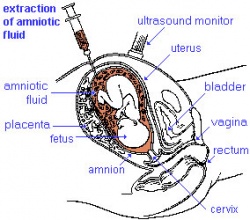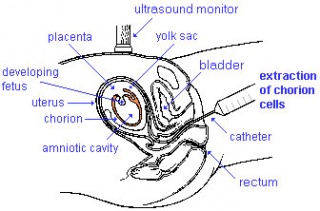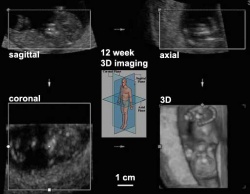Fetal Surgery
| Educational Use Only - Embryology is an educational resource for learning concepts in embryological development, no clinical information is provided and content should not be used for any other purpose. |
Introduction
There are a number of conditions detected by prenatal diagnostic techniques that can now be treated by fetal surgery. The two main surgical procedures are:
- Open fetal surgery - a major procedure involving a cesarean section, partial removal of the fetus for surgery, followed by return to the uterus.
- Fetoscopic surgery - A minor invasive technique involving a small surgical opening, the use of fibre-optics and special instruments to correct the abnormality without removal of the fetus from the uterus.
- This Embryology site is a developmental educational resource, it does not provide specific clinical details, you should always refer to a health professional.
| Assisted Reproductive Technology | In Vitro Fertilization | Journal - Prenatal diagnosis

|

|

|
| Amniocentesis | Chorionic villus sampling | Ultrasound |
Some Recent Findings
|
Abnormalities
Congenital abnormalities ranked of high importance.
Cardiac Malformations
- Critical pulmonary stenosis or atresia with intact ventricular septum
- Critical aortic stenosis
- Hypoplastic left heart syndrome and intact atrial septum
Congenital Diaphragmatic Hernia
Myelomeningocele (Spina Bifida)
- Myelomeningocele is the most common form of spina bifida.
- Open surgical repair carried out on more than 200 fetuses in the United States.
- Endoscopic surgical repair has been abandoned.
Obstructive Uropathy
Sacrococcygeal Teratoma
- Relatively rare condition, about 1 in 40,000 fetuses.
Thoracic Lesions
- Congenital pulmonary airway malformations.
- Minority subset of patients candidates for in utero treatment, mass large enough and in such an anatomically critical position that the fetal mediastinum is compressed, leading to impaired venous return with resulting fetal hydrops secondary to cardiac failure.
- Majority do not have an indication for prenatal treatment as the outcomes are excellent, tumours often regress throughout pregnancy and causing no neonatal or early childhood symptoms.
Twin-Twin Transfusion Syndrome
Procedures:
- Serial amnioreduction - to relieve intra-amniotic pressure and uterine size, and thus prolong the pregnancy, associated with a 50–60 percent survival rate of at least one fetus.
- Termination of the sicker twin - by cord occlusion, radio frequency ablation, or ligation may rescue the healthier twin. Only used in the presence of significant birth defects.
- Laser ablation of communicating vessels - either selective (preferred, only vessels communicating between the two fetuses) or non-selectively (all vessels crossing the dividing membrane are ablated) to attempt to protect one twin from hemodynamic disturbances in the other twin. Uterus can be accessed by: laparotomy to expose the uterus, laparoscopic placement of the fetoscope, and ultrasound-guided placement of the fetoscope.
- Septostomy - intervening membrane is punctured in an attempt to increase amniotic fluid in the oligohydramniotic sac, technique no longer used.
Subheading text based on Walsh et al.(2011).[2]
Genetic Diagnosis
Australia
A recent publication from NHMRC Medical Genetic Testing: information for health professionals (2010). This paper covers background information on all types of genetic tests, not just those associated with prenatal diagnosis.
Types of genetic tests
- Somatic cell genetic testing involves testing tissue (usually cancer) for non-heritable mutations. This may be for diagnostic purposes, or to assist in selecting treatment for a known cancer.
- Diagnostic testing for heritable mutations involves testing an affected person to identify the underlying mutation(s) responsible for the disease. This typically involves testing one or more genes for a heritable mutation.
- Predictive testing for heritable mutations involves testing an unaffected person for a germline mutation identified in genetic relatives. The risk of disease will vary according to the gene, the mutation and the family history.
- Carrier testing for heritable mutations involves testing for the presence of a mutation that does not place the person at increased risk of developing the disease, but does increase the risk of having an affected child developing the disease.
- Pharmacogenetic testing for a genetic variant that alters the way a drug is metabolised. These variants can involve somatic cells or germline changes. Even if these variants are heritable (that is germline changes), the tests are usually of relevance to genetic relatives only if they are being treated with the same type of medication.
USA
A new site developed by NIH "GeneTests" provides medical genetics information resources available at no cost to all interested persons. It contains educational information, a directory of genetic testing laboratories and links to other databases such as OMIM.
- Links: GeneTests | Medline Plus - Genetic Testing
Comparative Genomic Hybridization
This new test under development is based upon microarray-based comparative genomic hybridization (array CGH).
All fetal cells should have complete copies of maternal and paternal genomes. The test compares regions of fetal DNA that deviate from this "pattern" due to either too much or too little DNA, alterations reflect regions of the genome that are either copied or deleted. These genetic changes may therefore cause disease.
Ethics of Testing
Major developmental abnormalities detected early enough can be resolved far more easily than those discovered late in a pregnancy.
What are the ethical questions that are raised by prenatal testing? Future individual rights or parents rights? But what about diseases, like Huntington's, where a diagnostic test can be made but there are no current treatments for the postnatal (95% of cases adult onset) disease?
Huntington's disease
Guidelines for the molecular genetics predictive test
- Recommendation 2.1 "the test is available only to individuals who have reached the age of majority."
- Recommendation 7.2 "the couple requesting antenatal testing must be clearly informed that if they intend to complete the pregnancy if the fetus is a carrier of the gene defect, there is no valid reason for performing the test."
References
Books
Walsh WF, Chescheir NC, Gillam-Krakauer M, et al. Maternal-Fetal Surgical Procedures [Internet]. Rockville (MD): Agency for Healthcare Research and Quality (US); 2011 Apr. (Comparative Effectiveness Technical Briefs, No. 5.) http://www.ncbi.nlm.nih.gov/books/NBK54520
Reviews
<pubmed>22538233</pubmed> <pubmed></pubmed> <pubmed></pubmed> <pubmed></pubmed>
Articles
<pubmed></pubmed> <pubmed></pubmed> <pubmed>23093990</pubmed> <pubmed>17845745</pubmed>
Search Pubmed
December 2012 "Fetal Surgery" All (61774) Review (6772) Free Full Text (7635)
Search Pubmed: Fetal Surgery | Prenatal Surgery
- ART - Assisted Reproductive Technology a general term to describe all the clinical techniques used to aid fertility.
- blastomere biopsy - An ART preimplantation genetic diagnosis technique carried out at cleavage stage (day 3), excluding poor quality embryos, detects chromosomal abnormalities of both maternal and paternal origin. May not detect cellular mosaicism in the embryo.
- blastocyst biopsy - An ART preimplantation genetic diagnosis technique carried out at blastocyst stage (day 4-5), removes several trophoblast (trophoderm) cells, detects chromosomal abnormalities of both maternal and paternal origin and may detect cellular mosaicism.
- cell-free fetal deoxyribonucleic acid - (cfDNA) refers to fetal DNA circulating and isolated from the plasma portion of maternal blood. Can be performed from GA 10 weeks as a first-tier test or as a second-tier test, with women with increased probability on combined first trimester screening offered cfDNA or diagnostic testing.
- false negative rate - The proportion of pregnancies that will test negative given that the congenital anomaly is present.
- false positive rate - The proportion of pregnancies that will test positive given that the congenital anomaly is absent.
- free β human chorionic gonadotrophin - beta-hCG subunit of hCG used as a diagnostic marker for: early detection of pregnancy, Trisomy 21, spontaneous abortion, ectopic pregnancy, hydatidiform mole or choriocarcinoma.
- multiples of the median - (MoM) A multiple of the median is a measure of how far an individual test result deviates from the median and is used to report the results of medical screening tests, particularly where the results of the individual tests are highly variable.
- negative predictive value - The probability that a congenital anomaly is absent given that the prenatal screening test is negative.
- Non-Invasive Prenatal Testing - (NIPT) could refer to ultrasound or other imaging techniques, but more frequently used to describe analysis of cell-free fetal DNA circulating in maternal blood.
- polar body biopsy - (PB biopsy) An ART preimplantation genetic diagnosis technique that removes either the first or second polar body from the zygote. As these are generated by oocyte meiosis they detects chromosomal abnormalities only on the female genetics.
- positive predictive value - The probability that a congenital anomaly is present given that the prenatal screening test is positive.
- pre-implantation genetic diagnosis - (PGD, pre-implantation genetic screening) a diagnostic procedure for embryos produced through Assisted Reproductive Technology (ART, in vitro fertilisation, IVF) for genetic diseases that would generate developmental abnormalities or serious postnatal diseases.
- prenatal screening sensitivity - (detection rate) The probability of testing positive on a prenatal screening test if the congenital anomaly is present.
- prenatal screening specificity - The probability of testing negative on a prenatal screening test if the congenital anomaly is absent.
- quadruple test (maternal serum testing of a-fetoprotein Template:AFP, free B-hCG or total hCG, unconjugated estriol, and inhibin A) is a fetal chromosomal anomaly test usually carried out later in pregnancy (GA 14 to 20 weeks).
- single nucleotide polymorphisms - (SNPs) the variation in a single DNA nucleotide that occurs at a specific position in the genome.
- triple test - (maternal serum testing of a-fetoprotein Template:AFP, free B-hCG or total hCG, and unconjugated estriol) is a fetal chromosomal anomaly test usually carried out later in pregnancy (GA 14 to 20 weeks).
| Other Terms Lists |
|---|
| Terms Lists: ART | Birth | Bone | Cardiovascular | Cell Division | Endocrine | Gastrointestinal | Genital | Genetic | Head | Hearing | Heart | Immune | Integumentary | Neonatal | Neural | Oocyte | Palate | Placenta | Radiation | Renal | Respiratory | Spermatozoa | Statistics | Tooth | Ultrasound | Vision | Historic | Drugs | Glossary |
External Links
External Links Notice - The dynamic nature of the internet may mean that some of these listed links may no longer function. If the link no longer works search the web with the link text or name. Links to any external commercial sites are provided for information purposes only and should never be considered an endorsement. UNSW Embryology is provided as an educational resource with no clinical information or commercial affiliation.
- Australian and New Zealand - College of Obstetricians and Gynaecologists Intrapartum Fetal Surveillance Clinical Guidelines - Second Edition (June 2011)
- Canada - Society of Obstetricians and Gynaecologists of Canada
- USA
Glossary Links
- Glossary: A | B | C | D | E | F | G | H | I | J | K | L | M | N | O | P | Q | R | S | T | U | V | W | X | Y | Z | Numbers | Symbols | Term Link
Cite this page: Hill, M.A. (2024, April 27) Embryology Fetal Surgery. Retrieved from https://embryology.med.unsw.edu.au/embryology/index.php/Fetal_Surgery
- © Dr Mark Hill 2024, UNSW Embryology ISBN: 978 0 7334 2609 4 - UNSW CRICOS Provider Code No. 00098G